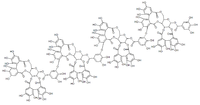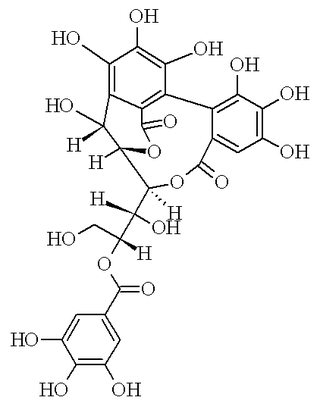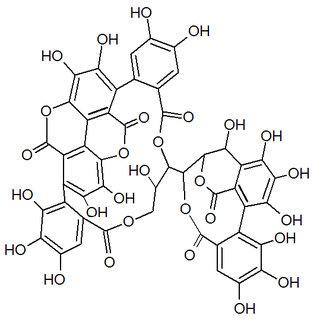 | |
| Names | |
|---|---|
| Systematic IUPAC name (10aR,11S,12aR,25aR,25bS)-2,3,4,5,6,7,17,18,19,20,21,22-Dodecahydroxy-9,15,24,27-tetraoxo-9,10a,11,12a,13,15,24,25a,25b,27-decahydrodibenzo[g,i]dibenzo[6′,7′:8′,9′][1,4]dioxecino[2′,3′:4,5]pyrano[3,2-b][1,5]dioxacycloundecin-11-yl (310aR,311S,312aR,325aR,325bS,810aR,811S,812aR,825aR,825bS,1310aR,1311R,1312aR,1325aR,1325bS)-15,16,32,33,34,35,36,37,317,318,319,320,321,322,64,65,82,83,84,85,86,87,817,818,819,820,821,822,114,115,132,133,134,135,136,137,1317,1318,1319,1320,1321,1322,163,164,165-pentatetracontahydroxy-39,315,324,327,5,89,815,824,827,10,139,1315,1324,1327,15-pentadecaoxo-39,310a,311,312a,313,315,324,325a,325b,327,89,810a,811,812a,813,815,824,825a,825b,827,139,1310a,1311,1312a,1313,1315,1324,1325a,1325b,1327-triacontahydro-2,4,7,9,12,14-hexaoxa-3,8,13(22,11)-tris(dibenzo[g,i]dibenzo[6′,7′:8′,9′][1,4]dioxecino[2′,3′:4,5]pyrano[3,2-b][1,5]dioxacycloundecina)-1,16(1),6,11(1,3)-tetrabenzenahexadecaphane-13-carboxylate | |
| Other names Rubusuaviin E | |
| Identifiers | |
| Properties | |
| C164H106O104 | |
| Molar mass | 3740.415 g/mol |
Except where otherwise noted, data are given for materials in their standard state (at 25 °C [77 °F], 100 kPa). | |
Lambertianin D is an ellagitannin found in Rubus lambertianus . [2]
It is tetramer of casuarictin linked by sanguisorbic acid ester groups between glucopyranose moieties. [2]

















